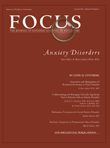Assessment and Management of Treatment-Resistance in Panic Disorder
Abstract
Panic disorder (PD) is a severe, persistant and potentially disabling anxiety disorder which affects 3.5 to 5% of individuals at some point. PD is characterized by one or more unexpected panic attacks followed by worry about additional attacks and/or the implications of the attacks. If attacks are sufficiently severe or frequent, they can promote marked, sometimes debilitating behavioral changes and avoidance (agoraphobia). We know from clinical experience and clinical trial outcomes that many PD sufferers are incompletely responsive to the initial treatment. Based on accruing evidence in the literature and clinical experience, inadequate treatment appears an important factor in treatment failure. In this article, strategies for optimizing PD treatment—including sufficient intensity of treatment—will be presented. A differential diagnostic approach for clinical evaluation of unsatisfactory response of PD treatment will be outlined. Finally, potential next-step treatments for unsatisfactory PD treatment outcome will be presented.



